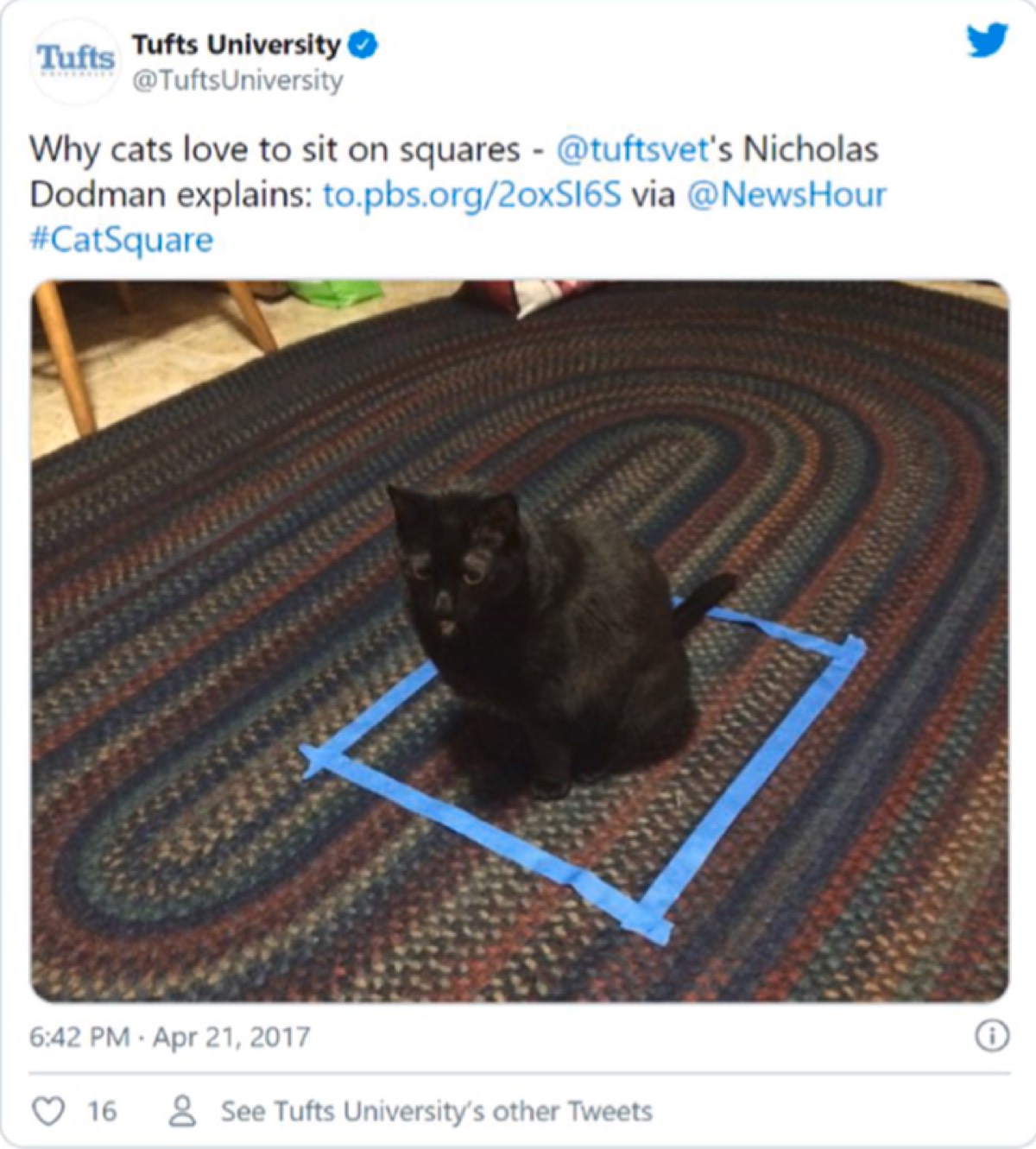| |

| Author |
Topic Options
|

 Posts:
Posts: 53170
 Posted: Posted: Fri Apr 30, 2021 7:37 am
$1: New study has scientists re-evaluating relative brain size and mammalian intelligence
Scientists from Stony Brook University and the Max Planck Institute of Animal Behavior have pieced together a timeline of how brain and body size evolved in mammals over the last 150 million years. The findings, published in Science Advances, show that brain size relative to body size—long considered an indicator of animal intelligence—has not followed a stable scale over evolutionary time.
The international team of 22 scientists, including biologists, evolutionary statisticians, and anthropologists, compared the brain mass of 1400 living and extinct mammals. For the 107 fossils examined—among them ancient whales and the most ancient Old World monkey skull ever found—they used endocranial volume data from skulls instead of brain mass data. The brain measurements were then analyzed along with body size to compare the scale of brain size to body size over deep evolutionary time.
"A big surprise was that much of the variation in relative brain size of mammals that live today can be explained by changes that their ancestral lineages underwent following the mass extinction and other cataclysmic events," says Jeroen Smaers, an evolutionary biologist, Associate Professor of Anthropology at Stony Brook University, and first author on the study. "This includes evolution of the biggest mammalian brains, such as the dolphins, elephants, and great apes, which all evolved their extreme proportions after the climate change event 23-33 million years ago."
According to the study, "big-brained" humans, dolphins, and elephants, for example, attained their proportions in different ways. Elephants increased in body size, but surprisingly, even more in brain size. Dolphins, on the other hand, generally decreased their body size while increasing brain size. Great apes showed a wide variety of body sizes, with a general trend towards increases in brain and body size. In comparison, ancestral hominins, which represent the human line, showed a relative decrease in body size and increase in brain size compared to great apes.
The authors say that these complex patterns urge a re-evaluation of the deeply rooted paradigm that comparing brain size to body size for any species provides a measure of the species' intelligence.
https://phys.org/news/2021-04-scientist ... -size.html
|

 Posts:
Posts: 53170
 Posted: Posted: Fri May 07, 2021 6:53 am
$1: What cats’ love of boxes and squares can tell us about their visual perception It is a truth universally acknowledged—at least by those of the feline persuasion—that an empty box on the floor must be in want of a cat. Ditto for laundry baskets, suitcases, sinks, and even cat carriers (when not used as transport to the vet). This behavior is generally attributed to the fact that cats feel safer when squeezed into small spaces, but it might also be able to tell us something about feline visual perception. That's the rationale behind a new study in the journal Applied Animal Behaviour Science with a colorful title: "If I fits I sits: A citizen science investigation into illusory contour susceptibility in domestic cats (Felis silvers catus)." The paper was inspired in part by a 2017 viral Twitter hashtag, #CatSquares, in which users posted pictures of their cats sitting inside squares marked out on the floor with tape—kind of a virtual box. The following year, lead author Gabriella Smith, a graduate student at Hunter College (CUNY) in New York City, attended a lecture by co-author Sarah-Elizabeth Byosiere, who heads the Thinking Dog Center at Hunter. Byosiere studies canine behavior and cognition, and she spoke about dogs' susceptibility to visual illusions. While playing with her roommate's cat later that evening, Smith recalled the Twitter hashtag and wondered if she could find a visual illusion that looked like a square to test on cats. Smith found it in the work of the late Italian psychologist and artist Gaetano Kanizsa, who was interested in illusory (subjective) contours that visually evoke the sense of an edge in the brain even if there isn't really a line or edge there. The Kanizsa square consists of four objects shaped like Pac-Man, oriented with the "mouth" facing inward to form the four corners of a square. Even better, there was a 1988 study that used the Kanizsa square to investigate the susceptibility of two young female cats to illusory contours. The study concluded that, yes, cats are susceptible to the Kanizsa square illusion, suggesting that they perceive subjective contours much like humans. But the 1988 study was conducted in the laboratory and "primed" the two feline subjects via standard operant conditioning methods. Smith wanted to design a similar study that increased the sample size and observed the cats' behavior in their natural environment—which is less stressful for cats than a lab environment—with no advance priming. A "citizen science" project involving cat owners recruited on Twitter seemed like just the ticket, especially given the ongoing COVID-19 pandemic. People were spending a lot more time at home with their pets, and they were likely to have more time to conduct the trials.  https://arstechnica.com/science/2021/05 ... erception/
|

 Posts:
Posts: 53170
 Posted: Posted: Mon May 10, 2021 6:03 am
|

 Posts:
Posts: 53170
 Posted: Posted: Tue May 11, 2021 7:35 am
$1: Mind-boggling magnets could unlock plentiful powerDr Greg Brittles' eyes gleam with excitement when he explains the project he is working on. "It's every engineer's dream really, to have a project that's technically challenging, which requires you to develop new technology and solutions to hard problems, but that are also simultaneously important for the world to have." Since finishing his research at Oxford University five years ago, he has been working for Tokamak Energy, a UK start-up that has plans to build a fusion reactor. Fusion is the reaction that powers the Sun and the stars. If that power could be harnessed on Earth it would provide a plentiful source of energy, from only a tiny amount of fuel and producing no carbon dioxide. What's not to love? The principle is easy enough to understand. Take two hydrogen atoms, add enough heat and pressure and they will fuse together to form helium. During that process some of the hydrogen mass is transformed into heat, which you can use to make electricity. The catch is that to make fusion happen here on Earth, you have to heat hydrogen isotopes to hundreds of millions of degrees, until they become so energetic they break apart into a whirling state of matter called plasma. The challenge has always been to contain that plasma. Stars do it with gravity, but on Earth the most common method is to use powerful magnetic fields to keep the plasma confined. Much of the engineering challenge has come down to building magnets. They have to be powerful enough to contain an insanely hot, whirling mass of matter, but not use so much electricity that your reactor uses more power than it generates.  https://www.bbc.com/news/business-56843149
|

 Posts:
Posts: 35270
 Posted: Posted: Tue May 11, 2021 12:58 pm
|

 Posts:
Posts: 53170
 Posted: Posted: Thu May 13, 2021 6:18 am
I always thought it was "That's odd".
|

 Posts:
Posts: 53170
 Posted: Posted: Thu May 13, 2021 6:19 am
$1: Better than holograms: 3D-animated starships can be viewed from any angle
Scientists at Brigham Young University (BYU) have created tiny 3D animations out of light. The animations pay homage to Star Trek and Star Wars with tiny versions of the USS Enterprise and a Klingon battle cruiser launching photon torpedoes, as well as miniature green and red light sabers with actual luminous beams. The animations are part of the scientists' ongoing "Princess Leia project"—so dubbed because it was partly inspired by the iconic moment in Star Wars Episode IV: A New Hope when R2D2 projects a recorded 3D image of Leia delivering a message to Obi-Wan Kenobi. The researchers described the latest advances on their so-called screenless volumetric display technologies in a recent paper published in the journal Scientific Reports.
"What you're seeing in the scenes we create is real; there is nothing computer generated about them," said co-author Dan Smalley, a professor of electrical engineering at BYU. "This is not like the movies, where the lightsabers or the photon torpedoes never really existed in physical space. These are real, and if you look at them from any angle, you will see them existing in that space."
The technology making this science fiction a potential reality is known as an optical trap display (OTD). These are not holograms; they're volumetric images, as they can be viewed from any angle, as they seem to float in the air. A holographic display scatters light across a 2D surface, and microscopic interference patterns make the light look as if it is coming from objects in front of, or behind, the display surface. So with holograms, one must be looking at that surface to see the 3D image. In contrast, a volumetric display consists of scattering surfaces distributed throughout the same 3D space occupied by the resulting 3D image. When you look at the image, you are also viewing the scattered light.
https://arstechnica.com/science/2021/05 ... th-lasers/
|

 Posts:
Posts: 53170
 Posted: Posted: Fri May 14, 2021 6:26 am
$1: In Mahle's Contact-Free Electric Motor, Power Reaches the Rotor WirelesslyThere's no wear and tear—and no rare earths, either  Automakers outside China are scrambling to develop electric motor designs that use no permanent magnets, partly because the magnets require rare earths, and mining rare earths causes pollution. It’s also partly because the mining is done in China, a formidable automotive competitor. These alternative motors turn the rotor using electromagnetic force alone; we’ve covered more than one such motor recently. One problem: Designs that put copper windings in the rotor have to transmit electricity to a moving target, and the point of contact—the slip ring—is subject to wear and tear. Today Mahle, a German auto parts company, unveiled a motor that’s free of both rare earths and of physical contact. Power is beamed into the rotor wirelessly, through induction, by a coil carrying alternating current. This induces a current in the receiving electrode, inside the rotor, which energizes the copper windings there to produce an electromagnetic field. That means there’s practically nothing that can wear out. “There are no contacts to transmit electricity, no abrasion, no dust formation, no mechanical wear,” Martin Berger, Mahle’s head of research, said Wednesday, in an online press conference. “Also I have to say, if one must service a non-magnetized rotor, it’s not difficult to exchange the rotor.” It may seem strange to try to minimize wear and tear in electric motors, seeing as they are already famed for their simplicity and durability. Unlike internal-combustion engines, electric motors have practically no moving parts, and they are fairly easy to take apart and put back together. Perhaps Mahle’s engineers got the idea from their longstanding work in wireless charging technology. Maybe the contact-free rotor design provides advantages beyond mere durability. https://spectrum.ieee.org/cars-that-thi ... o-contactsAnother article on this: Mahle's cheap, highly efficient new EV motor uses no magnets
|

 Posts:
Posts: 53170
 Posted: Posted: Mon May 17, 2021 11:29 am
$1: How humanity has changed the food it eats
Processed food isn’t just a modern invention, created in factories from artificial ingredients. It is as old as humanity itself and may have helped create our species, writes Nicola Temple.My first introduction to processed food began as a child in rural Canada, where we grew 90% of what we ate on our seven-acre homestead. After a carefree summer of catching fireflies and frogs and plucking sugar snaps from the vine, late August marked the start of winter preparation. In the stifling humidity of an Ontario summer, perched on vinyl 1970s kitchen furniture, we topped and tailed, shucked and shelled, and boiled and blanched – processing all of our home grown produce so that it would feed us through the long, cold winter. Yet, processed food these days has a far more negative connotation. The words conjure images of "cheese" covered polystyrene-like snacks or "just add water" meals with suspicious "flavour" pouches; these are the ultra-processed foods. Is it fair to paint all processed food with the same brush of disdain? We forget that innovations in food processing have also helped to improve nutrition, reduce food waste and provide us with more leisure time. It is far more complex than to claim all processed food is bad. Processed food has, for better or for worse (and likely both), changed our relationship with food. Long before that, it shaped us as a species. Our hominin relation, Homo habilis, which lived between 2.4 million and 1.4 million years ago, bares the first evidence of food processing. Unlike its evolutionary predecessors, habilis had relatively small teeth. It is thought that such an evolutionary trend could only begin if food was being manipulated before it reached the mouth. Pounding roots with rocks or slicing thin strips of meat to make it easier to chew could translate to about 5% less chewing. With less strain on the chewing apparatus – the jaws, muscles and teeth – the body can redirect those energetically expensive tissues elsewhere, causing the face to become smaller relative to the overall skull size. Homo erectus (1.89 mya – 108,000 years ago) and Homo neanderthalensis (400,000-40,000 years ago) had much smaller teeth than one would predict based on their skull sizes. Evolution could only favour such a reduction in tooth size if food had become easier to chew, and this is likely to only have been accomplished through thermal processing – cooking. https://www.bbc.com/future/article/2021 ... od-it-eats
|

 Posts:
Posts: 53170
 Posted: Posted: Tue May 18, 2021 6:21 am
$1: Nuclear reactions at Chernobyl are spiking in an inaccessible chamber Scientists monitoring the ruins of the Chernobyl nuclear power plant in Ukraine have seen a surge in fission reactions in an inaccessible chamber within the complex. They are now investigating whether the problem will stabilise or require a dangerous and difficult intervention to prevent a runaway nuclear reaction. The explosion at Chernobyl in 1986 brought down walls and sealed off many rooms and corridors. Tonnes of fissile material from the interior of a reactor were strewn throughout the facility and the heat it generated melted sand from the reactor walls with concrete and steel to form lava-like and intensely radioactive substances that oozed into lower floors. One chamber, known as subreactor room 305/2, is thought to contain large amounts of this material, but it is inaccessible and hasn’t been seen by human or robotic eyes since the disaster. Now, researchers have seen a spike in neutron emissions from the room, with levels increasing around 40 per cent since the start of 2016. This points to a growing nuclear fission reaction, so researchers are trying to determine if this surge will fizzle out, as previous spikes in other parts of the ruins have done, or whether they will need to find a way to access the room and intervene. Neil Hyatt at the University of Sheffield, UK, who studies nuclear waste disposal, likens the situation to “embers in a barbecue pit” and says “it’s a reminder to us that it’s not a problem solved, it’s a problem stabilised”. One suggestion for why this is happening is that a new structure placed over the ruined reactor in 2016 is causing the plant to dry out. When uranium or plutonium fuel decay radioactively, they emit neutrons, which can promote a fission reaction if the neutrons are captured by another radioactive nuclei. However, large amounts of water slow these neutrons down, preventing them from being captured. https://www.newscientist.com/article/22 ... e-chamber/
|

 Posts:
Posts: 53170
 Posted: Posted: Wed May 19, 2021 6:39 am
$1: Indigenous forest gardens remain productive and diverse for over a century
 In the 1930s, an archeologist from the Smithsonian wrote a short paper remarking on the exquisite vegetation around First Nation villages in Alaska. The villages' surroundings were filled with nuts, stone fruit, berries, and herbs—several non-native to the area and many that would never grow together naturally. The significance of these forest gardens went largely overlooked and unrecognized by modern archeology for the next 50-plus years. In the last few decades, archeologists have learned that perennial forest management—the creation and care of long-lived food-bearing shrubs and plants next to forests—was common among the Indigenous societies of North America’s northwestern coast. The forest gardens played a central role in the diet and stability of these cultures in the past, and now a new publication shows that they offer an example of a far more sustainable and biodiverse alternative to conventional agriculture. This research, which was done in collaboration with the Tsm’syen and Coast Salish First Nations, shows that the gardens have become lasting hotspots of biodiversity, even 150 years after colonists forcibly removed the inhabitants from their villages. This work, combining archeology, botany, and ecology, is the first to systematically study the long-term ecological effects of Indigenous peoples’ land use in the region. The gardens offer ideas for farming practices that might restore, rather than deplete, local resources to create healthier, more resilient ecosystems. https://arstechnica.com/science/2021/05 ... a-century/
|

 Posts:
Posts: 53170
 Posted: Posted: Mon May 24, 2021 10:02 am
$1: A blind man can perceive objects after a gene from algae was added to his eye
The 58-year-old man was blind, barely able to perceive whether it was day or night. After receiving gene therapy to add light-sensing molecules to one of his retinas, he could locate a notebook set on a table.
Scientists in Europe and the US are reporting today what they describe as the first successful use of optogenetics to improve a person’s vision. The feat involved introducing a gene from algae into the man’s retina.
“I think that a new field is being born,” Botond Roska, a professor at the University of Basel who led the research, said during a conference call with journalists.
In Nature Medicine, the authors describe how their patient lost his vision after being diagnosed 40 years ago with retinitis pigmentosa, a degenerative disease that destroys photoreceptors, the light-sensing cells in the retina.
https://www.technologyreview.com/2021/0 ... o-his-eye/
|

 Posts:
Posts: 53170
 Posted: Posted: Tue May 25, 2021 6:57 am
$1: How Humanity Gave Itself an Extra LifeBetween 1920 and 2020, the average human life span doubled. How did we do it? Science mattered — but so did activism. In September 1918, a flu virus began spreading through Camp Devens, an overcrowded military base just outside Boston. By the end of the second week of the outbreak, one in five soldiers at the base had come down with the illness. But the speed with which it spread through the camp was not nearly as shocking as the lethality. “It is only a matter of a few hours then until death comes,” a camp physician wrote. “It is horrible. One can stand it to see one, two or 20 men die, but to see these poor devils dropping like flies sort of gets on your nerves. We have been averaging about 100 deaths per day.” The devastation at Camp Devens would soon be followed by even more catastrophic outbreaks, as the so-called Spanish flu — a strain of influenza virus that science now identifies as H1N1 — spread around the world. In the United States, it would cause nearly half of all deaths over the next year. In what was already a time of murderous war, the disease killed millions more on the front lines and in military hospitals in Europe; in some populations in India, the mortality rate for those infected approached 20 percent. The best estimates suggest that as many as 100 million people died from the Great Influenza outbreak that eventually circled the globe. To put that in comparison, roughly three million people have died from Covid-19 over the past year, on a planet with four times as many people.  There was another key difference between these two pandemics. The H1N1 outbreak of 1918-19 was unusually lethal among young adults, normally the most resilient cohort during ordinary flu seasons. Younger people experienced a precipitous drop in expected life during the H1N1 outbreak, while the life expectancies of much older people were unaffected. In the United States, practically overnight, average life expectancy plunged to 47 from 54; in England and Wales, it fell more than a decade, from a historic height of 54 to an Elizabethan-era 41. India experienced average life expectancies below 30 years. Imagine you were there at Camp Devens in late 1918, surveying the bodies stacked in a makeshift morgue. Or you were roaming the streets of Bombay, where more than 5 percent of the population died of influenza in a matter of months. Imagine touring the military hospitals of Europe, seeing the bodies of so many young men simultaneously mutilated by the new technologies of warfare — machine guns and tanks and aerial bombers — and the respiratory violence of H1N1. Imagine knowing the toll this carnage would take on global life expectancy, with the entire planet lurching backward to numbers more suited to the 17th century, not the 20th. What forecast would you have made for the next hundred years? Was the progress of the past half-century merely a fluke, easily overturned by military violence and the increased risk of pandemics in an age of global connection? Or was the Spanish flu a preview of an even darker future, in which some rogue virus could cause a collapse of civilization itself? Both grim scenarios seemed within the bounds of possibility. And yet, amazingly, neither came to pass. Instead, what followed was a century of unexpected life. https://www.nytimes.com/2021/04/27/maga ... -span.html
|

 Posts:
Posts: 53170
 Posted: Posted: Wed May 26, 2021 6:22 am
This is more about Philosophy than Science, but Science does use Logic in the dissemination of fact, so Logic plays a big part in Science. $1: Master List of Logical Fallacies
Fallacies are fake or deceptive arguments, "junk cognition," that is, arguments that seem irrefutable but prove nothing. Fallacies often seem superficially sound and they far too often retain immense persuasive power even after being clearly exposed as false. Like epidemics, fallacies sometimes "burn through" entire populations, often with the most tragic results, before their power is diminished or lost. Fallacies are not always deliberate, but a good scholar’s purpose is always to identify and unmask fallacies in arguments. Note that many of these definitions overlap, but the goal here is to identify contemporary and classic fallacies as they are used in today's discourse. Effort has been made to avoid mere word-games (e.g., "The Fallacist's Fallacy," or the famous "Crocodile's Paradox" of classic times), or the so-called "fallacies" of purely formal and symbolic, business and financial, religious or theological logic. No claim is made to "academic rigor" in this listing.
The A Priori Argument (also, Rationalization; Dogmatism, Proof Texting.): A corrupt argument from logos, starting with a given, pre-set belief, dogma, doctrine, scripture verse, "fact" or conclusion and then searching for any reasonable or reasonable-sounding argument to rationalize, defend or justify it. Certain ideologues and religious fundamentalists are proud to use this fallacy as their primary method of "reasoning" and some are even honest enough to say so. E.g., since we know there is no such thing as "evolution," a prime duty of believers is to look for ways to explain away growing evidence, such as is found in DNA, that might suggest otherwise. See also the Argument from Ignorance. The opposite of this fallacy is the Taboo.
Ableism (also, The Con Artist's Fallacy; The Dacoit's Fallacy; Shearing the Sheeple; Profiteering; "Vulture Capitalism," "Wealth is disease, and I am the cure."): A corrupt argument from ethos, arguing that because someone is intellectually slower, physically or emotionally less capable, less ambitious, less aggressive, older or less healthy (or simply more trusting or less lucky) than others, s/he "naturally" deserves less in life and may be freely victimized by those who are luckier, quicker, younger, stronger, healthier, greedier, more powerful, less moral or more gifted (or who simply have more immediate felt need for money, often involving some form of addiction). This fallacy is a "softer" argumentum ad baculum. When challenged, those who practice this fallacy seem to most often shrug their shoulders and mumble "Life is ruff and you gotta be tuff [sic]," "You gotta do what you gotta do to get ahead in this world," "It's no skin off my nose," "That's free enterprise," "That's the way life is!" or similar.
Actions have Consequences: The contemporary fallacy of a person in power falsely describing an imposed punishment or penalty as a "consequence" of another's negative act. E.g.," The consequences of your misbehavior could include suspension or expulsion." A corrupt argument from ethos, arrogating to oneself or to one's rules or laws an ethos of cosmic inevitability, i.e., the ethos of God, Fate, Karma, Destiny or Reality Itself. Illness or food poisoning are likely "consequences" of eating spoiled food, while being "grounded" is a punishment for, not a "consequence," of childhood misbehavior. Freezing to death is a natural "consequence" of going out naked in subzero weather but going to prison is a punishment for bank robbery, not a natural, inevitable or unavoidable "consequence," of robbing a bank. Not to be confused with the Argument from Consequences, which is quite different. See also Blaming the Victim. An opposite fallacy is that of Moral Licensing.
The Ad Hominem Argument (also, "Personal attack," "Poisoning the well"): The fallacy of attempting to refute an argument by attacking the opposition’s intelligence, morals, education, professional qualifications, personal character or reputation, using a corrupted negative argument from ethos. E.g., "That so-called judge;" or "He's so evil that you can't believe anything he says." See also "Guilt by Association." The opposite of this is the "Star Power" fallacy. Another obverse of Ad Hominem is the Token Endorsement Fallacy, where, in the words of scholar Lara Bhasin, "Individual A has been accused of anti-Semitism, but Individual B is Jewish and says Individual A is not anti-Semitic, and the implication of course is that we can believe Individual B because, being Jewish, he has special knowledge of anti- Semitism. Or, a presidential candidate is accused of anti-Muslim bigotry, but someone finds a testimony from a Muslim who voted for said candidate, and this is trotted out as evidence against the candidate's bigotry." The same fallacy would apply to a sports team offensively named after a marginalized ethnic group, but which has obtained the endorsement (freely given or paid) of some member, traditional leader or tribal council of that marginalized group so that the otherwise-offensive team name and logo magically become "okay" and nonracist.
The Affective Fallacy (also The Romantic Fallacy; Emotion over Reflection; "Follow Your Heart"): An extremely common modern fallacy of Pathos, that one's emotions, urges or "feelings" are innate and in every case self-validating, autonomous, and above any human intent or act of will (one's own or others'), and are thus immune to challenge or criticism. (In fact, researchers now [2017] have robust scientific evidence that emotions are actually cognitive and not innate.) In this fallacy one argues, "I feel it, so it must be true. My feelings are valid, so you have no right to criticize what I say or do, or how I say or do it." This latter is also a fallacy of stasis, confusing a respectful and reasoned response or refutation with personal invalidation, disrespect, prejudice, bigotry, sexism, homophobia or hostility. A grossly sexist form of the Affective Fallacy is the well-known crude fallacy that the phallus "Has no conscience" (also, "A man's gotta do what a man's gotta do;" "Thinking with your other head."), i.e., since (male) sexuality is self-validating and beyond voluntary control what one does with it cannot be controlled either and such actions are not open to criticism, an assertion eagerly embraced and extended beyond the male gender in certain reifications of "Desire" in contemporary academic theory. See also, Playing on Emotion. Opposite to this fallacy is the Chosen Emotion Fallacy (thanks to scholar Marc Lawson for identifying this fallacy), in which one falsely claims complete, or at least reliable prior voluntary control over one's own autonomic, "gut level" affective reactions. Closely related if not identical to this last is the ancient fallacy of Angelism, falsely claiming that one is capable of "objective" reasoning and judgment without emotion, claiming for oneself a viewpoint of Olympian "disinterested objectivity" or pretending to place oneself far above all personal feelings, temptations or bias. See also, Mortification.
Alphabet Soup: A corrupt modern implicit fallacy from ethos in which a person inappropriately overuses acronyms, abbreviations, form numbers and arcane insider "shop talk" primarily to prove to an audience that s/he "speaks their language" and is "one of them" and to shut out, confuse or impress outsiders. E.g., "It's not uncommon for a K-12 with ASD to be both GT and LD;" "I had a twenty-minute DX Q-so on 15 with a Zed-S1 and a couple of LU2's even though the QR-Nancy was 10 over S9;" or "I hope I'll keep on seeing my BAQ on my LES until the day I get my DD214." See also, Name Calling. This fallacy has recently become common in media pharmaceutical advertising in the United States, where "Alphabet Soup" is used to create false identification with and to exploit patient groups suffering from specific illnesses or conditions, e.g., "If you have DPC with associated ZL you can keep your B2D under control with Luglugmena®. Ask your doctor today about Luglugmena® Helium Tetracarbide lozenges to control symptoms of ZL and to keep your B2D under that crucial 7.62 threshold. Side effects of Luglugmena® may include K4 Syndrome which may lead to lycanthropic bicephaly, BMJ and occasionally, death. Do not take Luglugmena® if you are allergic to dogbite or have type D Flinder's Garbosis..."
Alternative Truth (also, Alt Facts; Counterknowledge; Disinformation; Information Pollution): A newly-famous contemporary fallacy of logos rooted in postmodernism, denying the resilience of facts or truth as such. Writer Hannah Arendt, in her The Origins of Totalitarianism (1951) warned that "The ideal subject of totalitarian rule is not the convinced Nazi or the dedicated communist, but people for whom the distinction between fact and fiction, true and false, no longer exists." Journalist Leslie Grass (2017) writes in her Blog Reachoutrecovery.com, "Is there someone in your life who insists things happened that didn’t happen, or has a completely different version of events in which you have the facts? It’s a form of mind control and is very common among families dealing with substance and behavior problems." She suggests that such "Alternate Facts" work to "put you off balance," "control the story," and "make you think you're crazy," and she notes that "presenting alternate facts is the hallmark of untrustworthy people." The Alternative Truth fallacy is related to the Big Lie Technique. See also Gaslighting, Blind Loyalty, The Big Brain/Little Brain Fallacy, and Two Truths
. . .
http://utminers.utep.edu/omwilliamson/E ... lacies.htm
|

 Posts:
Posts: 53170
 Posted: Posted: Mon May 31, 2021 9:39 am
$1: Can we keep human inconsistency from confusing expert advice?
Everyone has biases. And everyone knows that everyone has biases, and that these biases affect our judgements. Bias is explainable, and our brains like things they can explain.
One of the leading explainers of our biases is economist Daniel Kahneman, famed for a Nobel win and his book Thinking, Fast and Slow. He's now teamed with Olivier Sibony and Cass Sunstein to write a book... that's... not about bias. Entitled Noise: A Flaw in Human Judgement, it deals with—you guessed it—noise, the variability among human judgements that is the result of humans being variable. We have distinct temperaments and personalities; we are different from each other, and we are different from ourselves, certainly from year to year but also even from hour to hour.
All of that noise is totally OK. But it is totally not OK when it means that one petty thief is granted bail while another must await trial in jail, or one asylum seeker gets admitted into the US while another does not, or one child at risk of abuse gets shunted into foster care while another stays put—all because they saw a particular judge on a particular morning.
An end to noise
The goal of the book is to eliminate noise. The first step is recognizing it, which isn't easy. Unlike bias, noise is not readily acknowledged. But it contributes just as much to errors as bias does. So eliminating it can reduce errors just as much as eliminating bias can.
In Thinking, Fast and Slow, Kahneman described the Nobel Prize-winning work he did with Amos Tversky about the many cognitive biases that often shape individuals' decisions and cause them to err. Noise expands on those ideas to explore why groups of people make errors and how to deal with it when they do.
The longest section of the book is devoted to defining and identifying noise—a justification for the measures outlined in the rest of the text. "Noise is variability in judgments that should be identical," the authors explain.
They are not talking about subjective matters of taste, like movie reviews or wine ratings, about which there obviously should be differences of opinion. They are talking about matters like criminal justice and medical diagnosis, in which a lack of consensus should not exist but does. And it exists to a much, much greater degree than you'd imagine: when shown a pair of fingerprints a second time months after first seeing them, forensic analysts make different decisions about if they match about 10 percent of the time.
https://arstechnica.com/science/2021/05 ... rt-advice/
|
 
|
Page 43 of 75
|
[ 1112 posts ] |
Who is online |
Users browsing this forum: No registered users and 17 guests |
|
|

